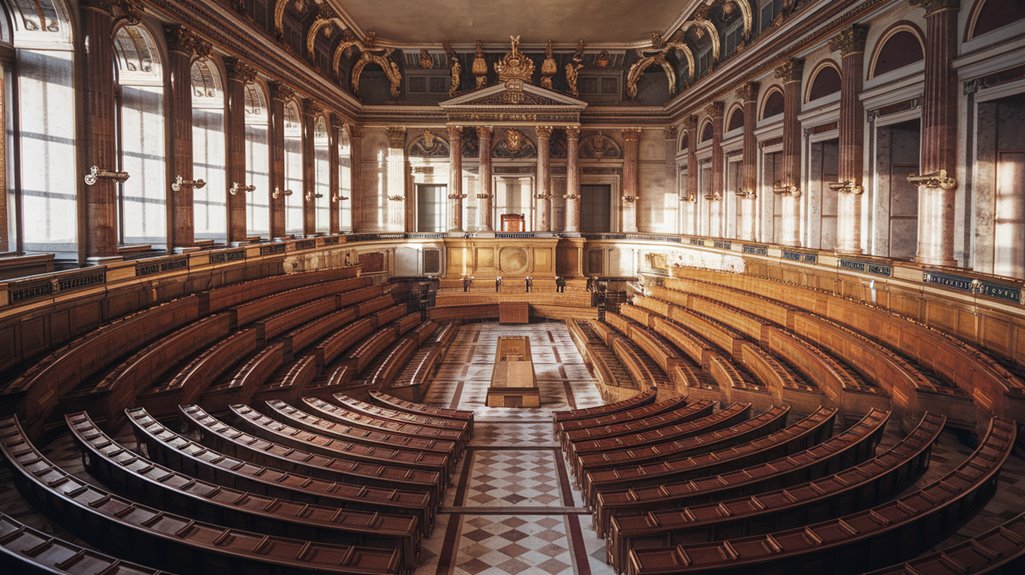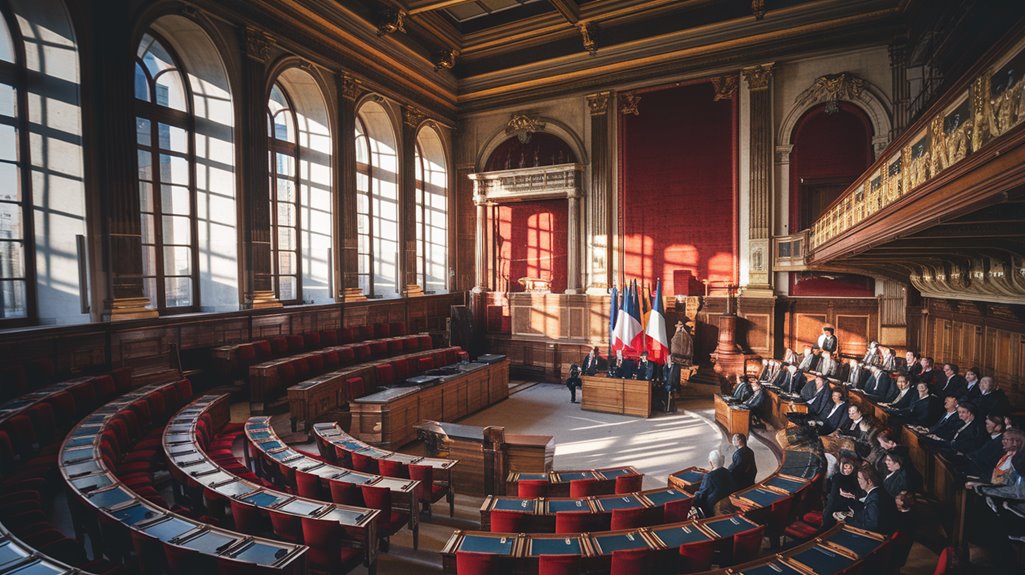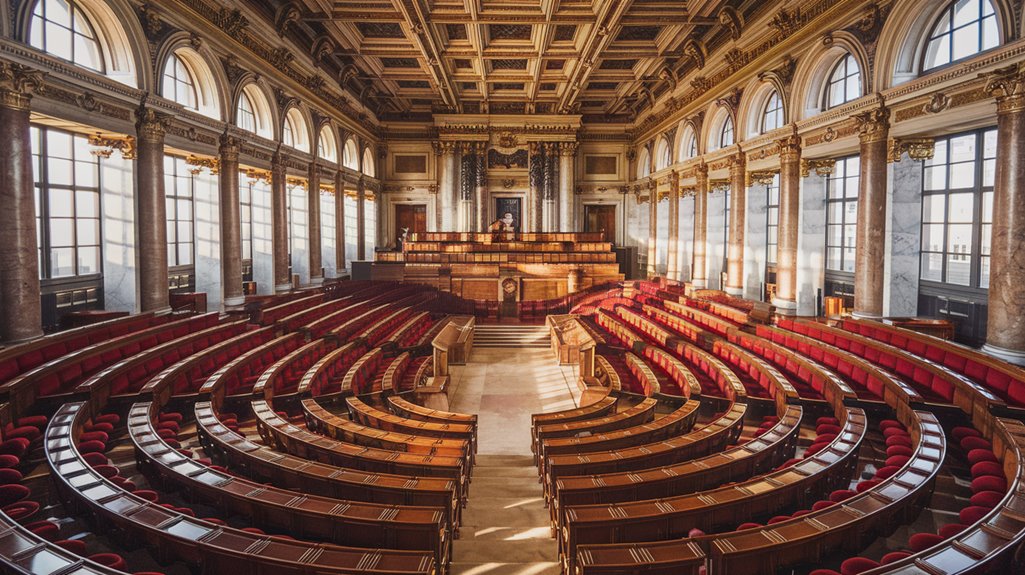Why Left vs. Right in Politics Began With Actual Seating
When you're choosing a seat in a movie theater, your position often reveals your personality – front row thrill-seekers differ from back row observers. Similarly, the terms "left" and "right" in politics stem from a simple seating arrangement during the 1789 French National Assembly. As monarchists clustered to the right of the president's chair and revolutionaries to the left, they unknowingly created a political compass that would shape centuries of ideological discourse. You'll find there's more to this story than just picking sides.
The French Revolution's Seating Legacy

While many aspects of modern politics have evolved over centuries, one of the most enduring legacies of the French Revolution is its influence on political terminology.
When you hear terms like "left-wing" or "right-wing" today, you're actually referencing a physical seating arrangement from 1789's French National Assembly.
The seating symbolism emerged during revolutionary debates over the monarchy's power. Those who supported absolute monarchy sat on the right side of the chamber, while those opposing it chose the left. The heated debates centered around food shortages and taxes, which were major catalysts for the revolution. These political labels quickly entered popular vernacular through newspaper coverage.
Moderates occupied the center, creating a clear visual representation of political divisions. This arrangement wasn't just temporary – it continued through subsequent French parliaments and eventually spread globally.
You'll find this terminology has shaped political discourse worldwide, though few realize its origins in actual seating positions.
From Physical Position to Political Identity
As the French Revolution's seating arrangements became more entrenched, they transformed from mere physical positions into powerful symbols of political identity.
What started as a practical way to organize opposing views on monarchial power evolved into a sophisticated system of political symbolism that we still use today.
You'll find that this ideological evolution happened gradually, as the terms "left" and "right" shed their literal meanings and became metaphors for broader political beliefs. These early political orientations proved remarkably stable, with party identification developing before most people formed complex ideological views.
This division laid groundwork for modern identity politics movements that continue to shape political discourse and activism.
The physical separation in the National Assembly helped people visualize and understand complex political differences.
Over time, this simple spatial arrangement provided a framework that would shape how you identify your own political stance.
Today, when you describe yourself as politically left or right, you're carrying forward a tradition that began with actual seating arrangements in revolutionary France.
The Global Spread of Left-Right Politics
Since its birth in revolutionary France, the left-right political spectrum has spread across continents, shaping how billions of people understand and discuss politics.
You'll find this framework deeply embedded in political systems worldwide, though its meaning varies considerably by region and culture.
The basis for this division traces back to when French assembly members sat on opposite sides during the French Revolution. As political polarization intensifies globally, you can observe how different nations adapt this spectrum to their unique contexts. This dynamic was evident in 2024 as right-wing populist parties gained significant electoral victories across Europe.
In Western Europe, it often centers on class divisions and economic policies, while other regions might emphasize different aspects of ideological diversity.
While the left typically champions social justice and redistribution, the right advocates for free markets and traditional values.
You'll notice this simple framework faces mounting criticism for oversimplifying complex political realities, especially as populist movements and new social issues challenge conventional political categories.
Modern Political Spectrum: Beyond Simple Seating
The political compass adds depth by measuring both economic and authoritarian-libertarian views, revealing ideological diversity that can't be captured on a single axis.
You might find yourself agreeing with policies from various positions, as economic beliefs don't always align with social ones. The two-axis model provides a more accurate representation of where people truly stand politically.
Understanding these nuances helps reduce polarization and shows how authoritarian populist movements often transcend traditional categories, demonstrating why we need more sophisticated frameworks to analyze today's political reality. Recent research shows that a large center exists, united primarily by their shared frustration with the current political system.
Historical Impact on Today's Political Discourse

Modern political labels of "left" and "right" originated from the French Revolution's legislative seating arrangements, where democratic socialists sat on the left and reactionaries on the right.
You'll find that this seating symbolism spread globally, profoundly shaping political discourse well beyond France's borders. Like the order of precedence in Victorian England, these political seating arrangements carried deep social meaning and hierarchical implications.
The National Assembly members first established this division in 1789, with supporters of revolution on the left and defenders of monarchy on the right.
The impact is particularly evident in how these terms gained traction in British politics during the Spanish Civil War debates of the 1930s.
This spatial metaphor reinforced political hierarchy and ideological divisions, as noted by sociologist Robert M. MacIver, who observed that the right typically defended established privileges while the left advocated for equality.
Today, when you hear politicians described as "left-wing" or "right-wing," you're experiencing the lasting influence of these historical seating arrangements on modern political language.










